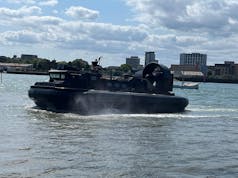Merlin Mk2 ASW from 820 Naval Air Squadron onboard HMS Queen Elizabeth hunted Norwegian Submarine HNoMS Utstein during an exercise.
In a Combined Anti-Submarine Exercise (CASEX), a group of ships and aircraft are given an area of water to search for submarines while the submarine acts as the enemy, attempting to undertake simulated missions against the surface forces.
Merlin Mk2 ASW from @820NAS conducted a CASEX against 'red team' Norwegian Submarine HNoMS UTSTEIN 🇳🇴
Using three types of sonobuoys: Cambs which is active, Hidar which is passive and Bathy which measures the temperature of the water as it descends. #UKCSG23 #StrongerTogether pic.twitter.com/47VdrYCkpQ
— UK Carrier Strike Group (@COMUKCSG) November 4, 2023
What is the Carrier Strike Group doing?
The UK Carrier Strike Group, led by flagship HMS Queen Elizabeth, recently completed the first phase of its autumn deployment. This involved participating in a series of simulated strike missions in the North Sea and Norwegian Sea alongside international naval partners.
“HMS Queen Elizabeth and her embarked jets and helicopters have proven their ability to provide the “punch” of the UK Carrier Strike Group during a series of simulated strike missions alongside international partners”, the press release stated.
Joining the aircraft carrier for these combat simulations were several ships from the UK and allied nations. Among these were the Type 45 destroyer HMS Diamond, Royal Fleet Auxiliary tanker RFA Tideforce, Norwegian ships HNoMS Otto Sverdrup and HNoMS Maud, Dutch ships HNLMS De Zeven Provincien and HNLMS Van Amstel, and the Belgian frigate BNS Louise Marie.
The exercises featured HMS Queen Elizabeth’s F-35 Lightning fighter jets from 617 Squadron, Merlin helicopters from 820 Naval Air Squadron, and Wildcat helicopters from 815 and 847 Naval Air Squadrons. Their missions varied, ranging from defending against aerial threats to suppressing enemy air defences and executing strike attacks.
Additionally, HMS Queen Elizabeth and her Carrier Strike Group showcased their medical capabilities, including advanced resuscitation techniques, trauma surgery, and casualty evacuations.
The next phase of the deployment will feature UK forces collaborating with ships and personnel from Joint Expeditionary Force (JEF) nations, which include countries such as Denmark, Estonia, Finland, Latvia, Lithuania, the Netherlands, Norway, and Sweden.
Commodore James Blackmore, Commander of the UK Carrier Strike Group, was quoted as saying, “CSG23 is off to a great start. Integrated training within the air and maritime environments, and alongside our European allies, has demonstrated the capability and agility of UK Carrier Strike.”
“Integrated training within the air and maritime environments, and alongside our European allies, has demonstrated the capability and agility of UK Carrier Strike”, reaffirmed Blackmore.














I think I could tell them where it is from here. 😈
Spoilsport, how. 🙈🤗. Anyhoo, BZ 820 nas
With your moniker I shouldn’t wonder! 😆
How many deployable, incl. aircrew, MK2s do we have?
and…
When will we get a MK3?
Hi David,
The Mk3 is the Commando version of the Merlin. It has already been upgraded to Mk4 to keep it going to 2030. The link below provides more details:
https://ukdefencejournal.org.uk/merlin-upgrade-extends-life-of-helicopter-to-2030/
My quick google search could not find any mention of an upgrade of the Mk2 ASW variant, which was a 2014 upgrade of the Mk1.
https://ukdefencejournal.org.uk/when-will-the-royal-navys-merlin-helicopters-be-retired/
Confusing ain’t it… but hope that helps.
Cheers CR
Thxs Charioteer!
So, 10 years in service and no upgrade in sight…
Sad state of affairs.
Just replied David, but it is awaiting approval – no idea why I linked to other UKDJ pages..?
Cheers CR
Good work. Making steady progress.
I wonder how small the area was and how ‘hard’ the sub tried..?
I only ask this given a series of recent posts on here about how subs usually manage to win against surface units, including against USN CSG’s…
I bet those small Norwegian subs are tough to find.
Cheers CR
I don’t really expect an answer by way..!
CR
Wonder whether a CSG, P-8s, and an Astute class vs. one or more Virginia class (proxy for next gen PLAN force) would not be the most realistic training scenario? Probably on the future BN calendar.
Hi FormerUSAF,
I would agree with you there, mate.
I think it is safe to say that a friendly sub is the best ASW asset to have available, but current force levels in the RN and I think fair to say across NATO as well are such that there is no guarantee that one will be available.
The RN and the RAF (P8) desperately need to be recapitalised. We can but hope.
Cheers CR
Hi fella, the Ula’s are fairly old ladies now (30+ yo), but still very effective SMs. It doesn’t get any harder than this for ASW units, it’s really good trg, despite the fact that using a SSN as the Opfor would probably be more realistic.
A bit of a dumb question here, but how do Maritime Patrol Aircraft hunt submarines? There are 300,000 square miles of sea in the British Economic Zone alone, and what about hunting subs in the North Atlantic? You can’t just pepper random spots with sonobuoys, can you?
So is overflight using other plane-based sensors (eg magnetic or temperature anomoly) good enough to get an idea? Or is it all intelligence based from our subs, frigates and allies, so we already know there’s a sub in the area, whose position a P8/MQ-9B can narrow down with sonobuoys etc?
Dear Jon, if you know, you aren’t going to tell. If you don’t know you ask questions that amuse those that do…….
Depending on where you are operating in the World, there are other sensor systems that can point towards the area where a sub was detected and tracked.
If you’ve read a bit of Tom Clancy or had experience with ASW? You’ll know what I’m talking about, especially in the North Atlantic.